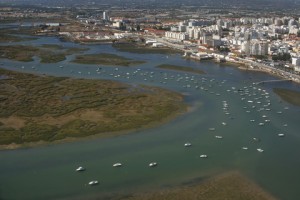 Founded in 1987, the Ria Formosa Natural Park it is an area protected by the Natural Park status, an extension of 60 kilometers along the Algarve coastline between Ancão, on the municipality of Loulé and Manta Rota, on the municipality of Vila Real de Santo António, being considered one of the most beautiful natural parks on the Algarve.
Founded in 1987, the Ria Formosa Natural Park it is an area protected by the Natural Park status, an extension of 60 kilometers along the Algarve coastline between Ancão, on the municipality of Loulé and Manta Rota, on the municipality of Vila Real de Santo António, being considered one of the most beautiful natural parks on the Algarve.
It occupies a surface of about 18,400 hectares, covering parts of the municipalities of Loulé, Faro, Olhão, Tavira and Vila Real de Santo António. Before 1987, the Ria Formosa Natural Park presented the status of Natural Reserve, established in 1978.
Great part of the Reserve area, corresponds to the lagoon system of Ria Formosa, a string of sandy islands and peninsulas placed parallel to the maritime coast, protecting a lagoon that forms a maze of marshes, channels, vasa zone and small islands.
At South, this cord, consists essentially by the Ancão Peninsula, that includes the Ancão Beach and the “island of Faro” (incorrectly called Island), the islands of Deserts/Barreta, Farol-Culatra (where it is the lighthouse of Santa Maria and the fishing village of Culatra in front of Olhão), the islands of Armona-Fuseta, of Tavira, Cabanas and the Cacela Peninsula, which includes the Cacela Velha Beach and the Fábrica Beach.
At North, in its all extension, the lagoon is dotted with salines, small sandy beaches, by strong land, arable land and by fresh water lines that in the same drain, which are the São Lourenço River, the Rio Seco, the Marim Riverside, The Mosqueiros Riverside, the Gilão River, the Almargem Riverside and the Cacela Riverside.
Its maximum width, there is near the city of Faro, with about 6 Kilometers and variations that on its extremes, to west and east, reach a few hundred meters.
The Ria Formosa lagoon system, has a triangular form, being that despites being recognized as a riverside, in practical terms, does not constitute as such, once an riverside is characterized by a fluvial valley flooded by the sea, that is not the case with the Ria Formosa, due to the fact that the lagoon is not a fluvial valley and by being formed by barrier islands.
In the area of Ria Formosa, take shelter in winter bird species from the North and of the central Europe, as the trumpeter-Duck, the Common teal, the curlew and the Grey Plover.
One of the symbols of the Park is the common caiman, a rare species that exits in Portugal and reproduces exclusively on the respective Algarve lakes. On the Park, it can also be observed the flamingo, the round wing eagle, the woodcock and the kingfishers.
The Chameleon, which is almost extinct in Europe, is another inhabitant of the Park. At the botanical level, the area also presents a great interest, especially the by the vegetation of the dunes and marsh areas.
Ria also presents a great economic importance due to the existing variety of fish, seafood and shellfish, especially to Olhão, city also known for being the capital of the Ria Formosa. Are abundant in the Ria Formosa, the bream, the sea bass or the shrimp Ria. In the area, it is cultivated the clams, leaving the area about 80% of the total export of clams in Portugal.
Another important economic activity existing in the park of Ria Formosa Nature Reserve, is the extraction of salt in saline that currently are also places of refuge for some species.
Some of the saline of the Park became leading industries of aquaculture fish, having attracted foreign capital and foreign knowledge. The Ria Formosa Natural Park, has its headquarters and its Interpretation Centre in Olhão, near the Olhão Camping Park, in Marim and it provides to its visitors, a pedestrian walk of 3 kilometers, in which, it is possible to visit different places.
Between the same places, it highlights a roman station of the century IV, with traces of ancient fish salting tanks, a tide mill, a tuna boat, that carried the fish to the canneries of the area, a bird observatory at liberty, an Aquarius attached to the Environmental Education Center, a center recovery of birds, where there are rehabilitate injured birds, a breeding center and creation of water-dogs of the Algarve, located in the Environmental Education Centre of Marim.
It is also possible to visit the Chalet of the Poet João Lúcio, where it works currently an Ecoteca.
Ria Formosa Natural Park
Centro de Educação Ambiental de Marim – Quelfes
8700-194 Olhão
Telephone- (351) 289 700 210
Fax- (351) 289 700 219
E-mail- pnrf@icnf.pt
www.icnf.pt







